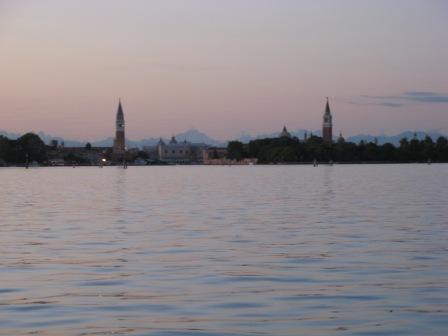Search results
17 results found.
17 results found.

I am now re-establishing radio contact with the rest of the world. The recent crackling silence was completely predictable, at least to me. May is a great month if you’re a plant, but if you’re me, it’s an Olympic biathlon involving two of the city’s three biggest boating events: the corteo for the Festa de la Sensa, on Ascension Day (May 12 this year), and the Vogalonga (May 19).
Once again, I dedicated two weeks to working in the registration office for the Vogalonga. Sound simple? The first week, yes. The second week, right up to 6:00 PM the day before the event, was a crescendo of desperation — not on my part, but those who came, as one hollow-eyed supplicant put it, “A thousand kilometers over the Alps with our boats,” thinking they could sign up at the last minute and discovering that all the 1,700 bibs, one per boat, had already been booked.
I heard stories about people needing a number for their dying best friend. I didn’t hear any pleas based on expiring grandmothers or promises to small children, but the accumulated emotional tension began to take a toll on me. It wasn’t just the exclamations of doomed desire that were so tiring (“But why?” “But why?” “I have the money right here” “Can’t you find just one number for me?” “But I didn’t know” “I didn’t read the website” “I don’t have internet” “We’ve come all this way” “”Noooooooooooo, it can’t be truuuuuuuue”), it was my irritation at situations which could easily have been prevented if even one of their group had had a functioning medulla oblongata. Or whatever part of the brain governs logic and rationality. If there is such a part.
While everybody who already had their numbers were working themselves into a froth over the unpleasant weather forecast, I and my colleagues were struggling to resolve many silly and time-consuming and avoidable problems. Reservations made but not paid for; payments that didn’t correspond to the booking; adding people to boats; subtracting people from boats; doing long division of people from boats: the single reservation for 20 rowers who were assumed by us to all occupy the same boat, but which it turned out were each rowing by themselves, hence requiring 19 more numbers. That was fun. “You need 19 numbers? Sure, I’ll just make them right here for you, like Subway sandwiches. You want pickles?”
Compared to all that, rowing the event is almost always easier, and more enjoyable, and more, well, rational.
You might have heard that it rained; you might have heard that the rain was something epic! That some boats capsized! Frankly, it was all much better than I’d feared. The rain came down in hurled handfuls of big hard round drops, then shifted, like a shower-head, to fine, thin and steady, then heavy and steady, then lots of little drizzly drops, then another downpour, then a pause, then another downpour. After Mazzorbo, the sun came out and we all dried off. As for overturned boats, if you ride a horse, what can happen to you? You fall off. If you’re in a boat, what can happen? You fall in. Lino’s fallen in countless times. I’ve fallen in, in January, no less. Get a grip, people.
That said, however, falling in isn’t equal for everyone. We heard later from a friend who had been rowing in a big Venetian boat that at Mazzorbo a rower in a single kayak decided to cross their bow at the last moment, got dinged, and over he went. But he couldn’t manage to come up because he had lashed all sorts of accoutrements, luggage, supplies, and even himself, to his kayak, which meant he couldn’t manage to right it and he couldn’t get out of it either. Think about it. Think medulla oblongata. Happily, the Venetian rowers managed to haul him back over and up into the air, but it was a very close call.
They also saw another boat capsize (the reasons for this aren’t clear — we weren’t in a hurricane) — it was a kayak again, this time for two rowers which, as our friend explained, also contained two very small children, one of whom was about three months old. The only glimmer of intelligence in that scenario was that the presumed parents had fitted their kids with lifejackets. People like this shouldn’t be allowed out of the house, much less into a boat.
There was the by-now traditional logjam in the Canale di Cannaregio, caused by the by-now traditionally inept, vision-impaired, brain-dead coxswains on the long rowing shells who seem not to understand that their boat needs to keep going straight forward and that their job is to see that it gets done. Big long boats slewing around slaunchwise and getting stuck are like big expensive beaver dams forcing all the arriving boats to jam up. It’s not just that they create problems — they don’t know what to do to fix them. As we see in the video by a certain Bas Schols; here’s the link for those who don’t see the clip: http://www.youtube.com/watch?v=qRyEnCKno3o .
A close second for the prize for Best Way to Create Problems goes to the people who just stop rowing and sit there in their boat, usually in narrowish spaces or at blind corners. You can hardly ever discover a reason for this. Of course they’re tired; we’re all tired. But when they’re driving in the center lane of the highway back home, do they just stop when they feel like it and sit there? I feel doubtful.
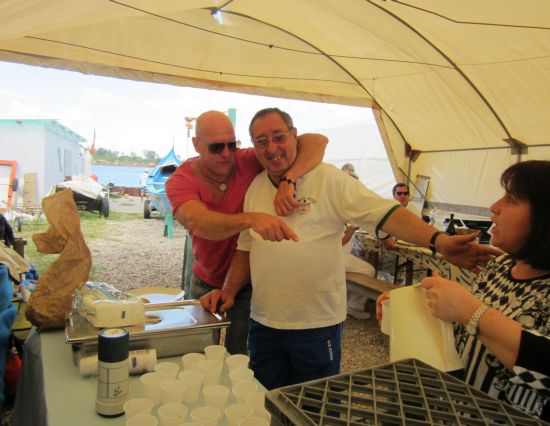
The Sunday before all this, May 12, was the Festa de la Sensa, and we participated in the commemoration of the “Wedding of the Sea.” We row out toward the Lido, following the big fancy ceremonial boat called the “Serenissima,” past the Morosini Naval School where the cadets are lined up along the embankment, as sharp as creases in starched organdy, shouting “Urrah!” when commanded to do so by the bosun’s whistle. That is absolutely the coolest thing about the entire event, though of course tossing the wreath into the water to commemorate the dead sailors is important too. And a ring-like object with ribbons tied onto it also gets blessed and tossed. Another chance to be crushed together in a boat-scrum, but at least here we all know each other and actually know how to move our boats around. That’s it for boats.
The rest of the month is a rapid unraveling of assorted appointments and events. For example, I sat most of the afternoon waiting for the long-expected boiler repairman to come replace the replacement washer from a few weeks ago. He was supposed to come in the morning, but only by calling up did we learn that he’d been moved to the afternoon. Dazzling efficiency! We could be in Sweden! Wait — it’s gets better. He phoned at 3:30 to say he couldn’t come because they hadn’t given him the part he needed to install. They thought they had, police said. (I am adhering to the practice recommended by the old city editor to the cub reporter, my former boss, who told him, “You can write anything you want to, as long as you add ‘comma police said.””)
At 6:00 it was off to the Generali Insurance Company’s boathouse for the presentation of the restored 8-oar gondolone. We needed to swell the ranks, it seemed, so we were there. We try to be good sports on land as well as sea. I was hoping they’d have cookies, but they got in a caterer and had hors d’oeuvres and asparagus risotto. I like being wrong like that.
Tomorrow afternoon Lino will be at Malamocco for hours, as one of the judges overseeing the eliminations for the next official rowing race (Sant’ Erasmo, June 2). That evening, dinner at the Non-Commissioned Naval Officers Club, a cholesterol-laden thank-you from a group of young French students because not only did we pick up the dropped/lost wallet of one of their members (containing 70 euros and also an address) but thanks to Skype and the fact that little Pauline’s father was home when I called, we managed to return it to her the next day. And a big shout-out to Mrs. Rideout and Mrs. Gordon, whose draconian French courses in high school are still paying off, if only in fractured form.
Friday evening, the annual corteo to transport the statue of Our Lady of Succor (“Maria Ausiliatrice”) from the church of San Pietro di Castello to the church of San Giuseppe. This year we’re going to be carrying as many people as we can, hoping to transfer into Venetian boats many of those who usually follow us on foot along the fondamente.
Saturday, a batch of us are off to Burano to collect four of our tornado-devastated boats from the boatyard where they have been repaired. We’re either towing or rowing them back; it doesn’t seem clear yet which one. I’m for rowing, myself, not that anyone consults me. The forecast isn’t too pretty.
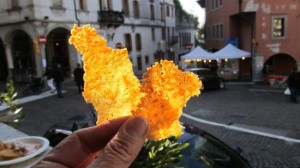
Sunday, we’re going with a big group in a bus to Trieste to the annual reunion of the veterans of the Automobile Corps. Lino did his compulsory 18-month military service in Rome with this arm of the armed forces, repairing and maintaining Jeeps, trucks, and assorted ministerial vehicles. He recently joined the nearest chapter of the motorized veterans, and the big outing sounds like it’s going to be fun, except for the promised thunderstorms and drenching rain.
We’ll get to march around the Piazza dell’Unita’ d’Italia for a while, then go off to some countryside establishment to gorge on Friulian specialties (think San Daniele prosciutto and frico, or fried cheese) — possibly the true purpose of the expedition. Then to visit some famous nearby monastery blanketed by rose gardens. We’ll have to get up before 5:00 to get the train to Treviso, the starting point, but I’d walk to Treviso for a shot at a plate of frico.
Next week’s calendar is ominously empty. I say “ominous,” because you know how Nature feels about a vacuum.
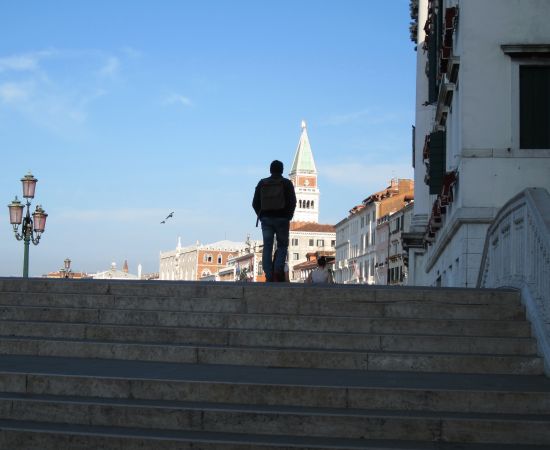
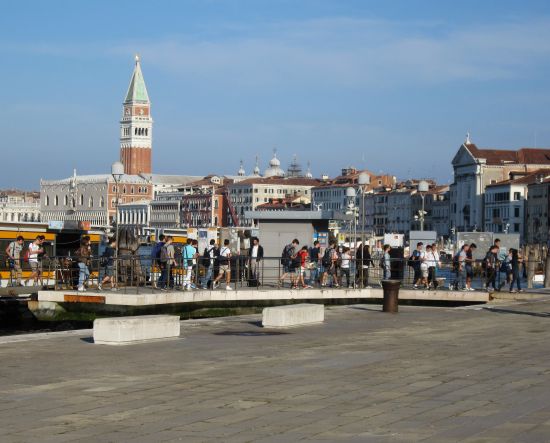

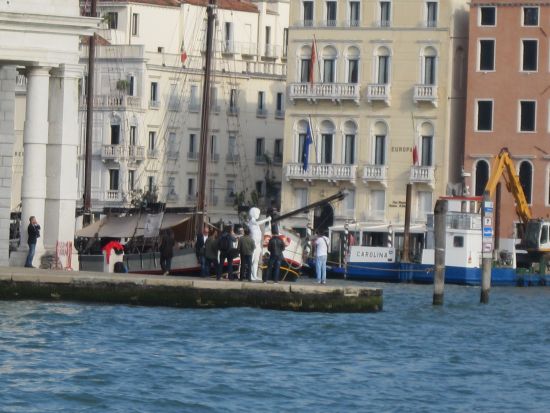

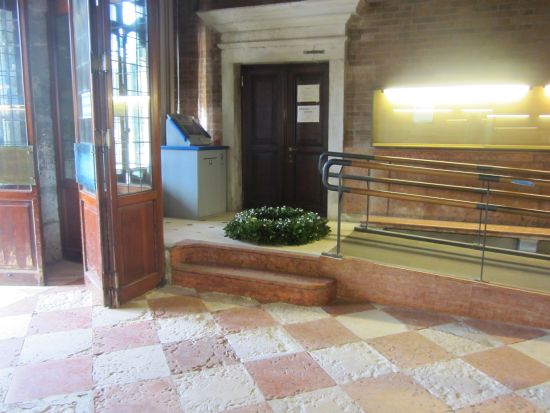
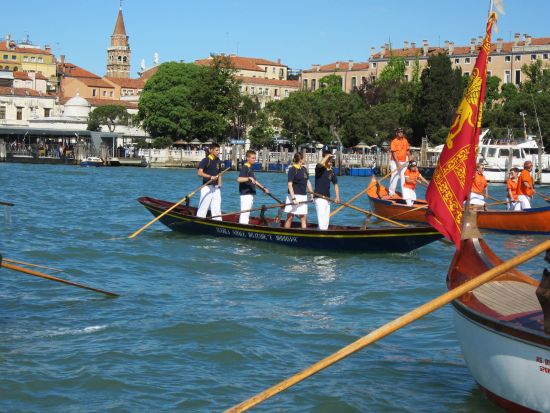

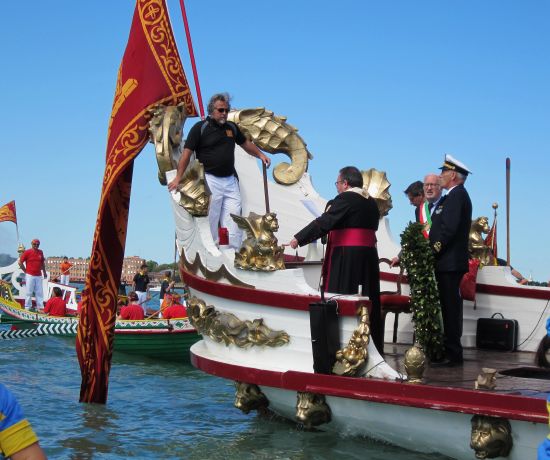
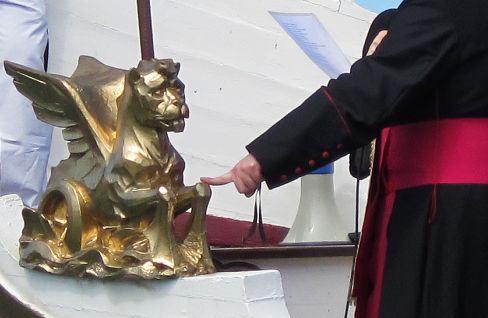
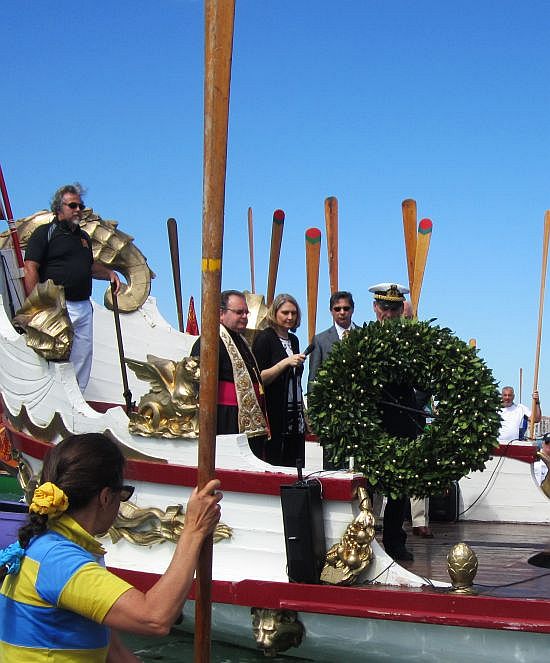

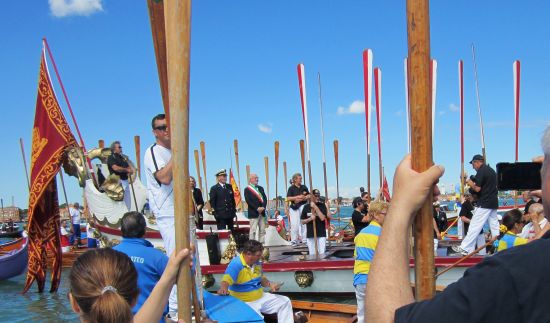

Anyone who knows that last Sunday was the 38th Vogalonga (I was there, rowing on the six-oar balotina, as last year) might be surprised to hear that that event is not filed under “Big day” in Erla’s Cosmic File Cabinet.
My big day was day before yesterday, hereinafter referred to as the Apparition of the First Magnolia Blossom.

My mother had the habit (obsession) of remaining on the lookout for little signals throughout the year — animal, vegetable, mineral, comestible, aural, but especially vegetable. The way she watched for them made them seem important. And evidently a random twist of the old DNA has passed this persistent little practice on to me. The first seppia. The first frog-song. It’s such a part of how I see the world that I find it odd that everybody doesn’t do it.
I used to watch for the very first leaves coming out on the small weeping willow on the canal near our first dwelling. First leaves are celestial, filmy, diaphanous. Complete, full-grown, ready-to-use, batteries-included leaves are not. And don’t tell me that the anticipation was more meaningful/pleasurable/important than detecting the nascent foliage itself. You might convince me that the voyage matters more than the destination, but anticipation with no fulfillment is dumb.
So I have been keeping the huge magnolia tree near the Giardini vaporetto stop under close surveillance. Tell me why the first blossom could possibly matter. No wait — don’t tell me. It matters.
Now I have seen it and I feel happy. I’m not sure what I’m going to be tracking next, but there will definitely be something. Followed by something else. Until December 31, and then I start over.

Considering how well my personal Vogalonga went this year (along with my six boatmates), it’s taken me this much time to find anything to say about it other than that.
Also, I have no photographs whatsoever of us, for one reason which explains both these little paragraphs. We didn’t start in the Bacino of San Marco.
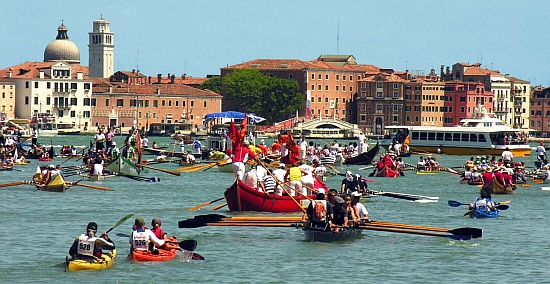
The tradition in any boat I’ve been in that includes Lino (all but one — the first year — of the 16 editions I’ve joined) is that we start in the Bacino of San Marco when the cannon fires and all the bells ring. It’s thrilling and I love this moment, which is all too brief because we then commence rowing, along with a mass of boats surrounding us like migrating krill.
This means that while we have the chance to savor the richness of the moment — boats, cannon, bells — the krill create many well-known problems along the way. Such as at what I think of as the “death corner,” the first turn at the point of Sant’ Elena, where any number of non-Venetian rowers suddenly discover some problem which they hadn’t planned on facing — such as a tricky current, or some boats around them also having problems, or, I don’t know, existential lack of nerve, like cragfast climbers. You can expect to see at least one capsized vessel here, and a batch of confusion from the mass of boats trying to avoid it.
Then there are the snaky curves along the flank of Sant’ Erasmo, also excellent territory for making miscalculations of available space, relative speeds, and wind direction and force.
Then, of course, there is the every-year-more-difficult (I meant to say “ghastly” but changed my mind) passage into and through the Cannaregio Canal, where inexperience, fatigue, and lack of common sense create packs of boats like Arctic ice.
This year we didn’t have any of that — I mean, ANY of that — for one surprising reason. We forgot our boat’s number, without which the boat can’t be checked at various points along the way and hence acknowledged as officially doing the course.
So when the cannon/bells/confusion began at 9:00 AM, we were back at the boat club behind Sant’ Elena digging the numbered bib out of Lino’s locker.
Which meant that we joined the scrum after the “death corner,” and — this was unexpected — in some way near the head of the herd. Please note that this does not mean we started early, as some unsporting people tend to do. We slipped into the traffic stream at 9:10, roughly the same time it would have been for us at that point even if we’d started in the usual place.
The result of all this being that not only did we cover the entire course in record time without even breaking a sweat (three hours — unheard of), we were able to do it in unearthly tranquillity. Yes, there were other boats, but noticeably fewer at that stage. We slithered along Sant’ Erasmo as if there wasn’t anybody else around, and we entered the Cannaregio Canal (over which I always see an invisible sign saying “Abandon all hope, ye who enter here”) as if it were a normal day, only better: The reasonable number of boats ahead of us were proceeding in a reasonable way at a reasonable speed and behaving, well, reasonably. I had never imagined I could see such a thing.
The only flaw in the ointment, as a friend of mine used to say, was that we were also ahead of the photographers. We missed the departure, which is always good for spectacular pictures, and we missed the mass return, ditto.
So unless some unknown photographer makes him- or herself known, I’m just going to have to keep my memories dusted and polished, because there isn’t anything else I have to show for this event.
It was so wonderful that I’m already trying to think of ways to convince the crew to leave before 9:00 next year. If all goes well, I’ll be able soon to report that we finished the course before the others had even started it.
Crazy? Unsporting? Simply wrong? Yes indeed. But now the rot has set in.
My earlier post about Race Day as a whole didn’t say anything about what I was doing while the world was ending for some of the racers.
I can tell you what I wasn’t doing: Screaming my lungs out for the Vignottini, which would have been ridiculous considering that they were already five car-lengths in the lead. No danger of anything rear-ending them last Sunday if they’d come to a sudden stop. I felt cheated, somehow. I fully intended to be screaming. Never mind. Life will probably provide another opportunity for screamage.
What the Storica means for us at the club — and it’s more or less like this every year except this year it was even better than usual — is the following:
Saturday morning: Whoever is free comes to titivate their boat. There was a small chain gang working on the caorlina, and an even smaller one (including me) working on the gondolone. We had to sandpaper and polish all the brass, including the big ornamental ferri of the prow and the bow. Lino and Lucio worked at nailing and screwing down various bits that had gone adrift over the months, and then there was varnishing the whole thing. She is now a dazzling vision of delight, and will remain so for, oh, maybe a month. It depends on the weather how fast the brass will lose its luster.
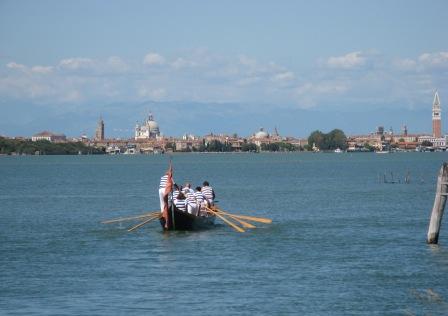
At 2:00 we dressed in our club best — blue and white tank top and white skirt (women), white pants for the men. Lino was dressed in his judge’s outfit, as he was on duty for two of the four races.
We rowed across the lagoon with some breeze but not too much. We crossed the Bacino of San Marco (waves, as always, but not as bad as usual because the traffic is limited this afternoon) and dropped Lino near San Marco, where he went to join the rest of his merry band of judges at the Tourism Office (regata division).
We rowed around the Bacino for a little while until it was time for the corteo, or boat procession, to form up. There is no real Italian way to express the concept of “forming up,” as the concept doesn’t exist. I’m not sure there is even anything close that you could compare it to, in order to explain to someone here what it might involve, or why it might matter. They’d just give you that “Well you’re perfectly welcome to try it if you want to but don’t get me involved” look.

Each boat has a number on its bow which indicates its order in the lineup. The number’s only discernible use is to help the speaker on the reviewing stand (the “Machina,” MAH-keen-ah) to identify the particular organization the boat belongs to as it drifts past. That part actually works pretty well.
We had number 11 and were probably two-thirds of the way back when the thing got going. You ask why we were so far back? Because the corteo wranglers had given absolutely no signal of any kind to indicate the imminent departure of said corteo. Evidently order isn’t foremost on their list of concerns either.
So we rowed in a slow and stately way up the Grand Canal (sometimes I surprise myself, at how normal doing something like that has come to be — then I suddenly snap to and think, Holy Crap! This is incredible!). The first regatas that might correspond somewhat to the current “regata storica” were arguably the series of races organized in January 1315 by doge Giovanni Soranzo. (In the 19th century it was called the “regata reale,” or royal regata). The corteo was added to the program much, much later, to evoke the arrival in Venice in 1489 of Caterina Cornaro, a Venetian noblewoman who was briefly also queen of Cyprus. It’s as good an excuse as any to add just that much more glamour — or glitter or marabou or whatever looks good — to the event.
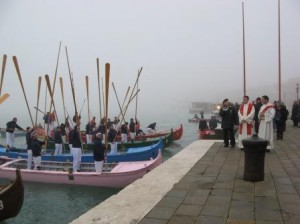
At certain points along the route we perform an alzaremi, or oar-raising, the classic Venetian waterborne ceremonial salute which looks thrilling. Too bad it’s been done to death by now. Lino thinks it should be limited to very few and very important moments, and I agree. But on this occasion, there are clumps of people all along the way who yell “alzaremi” at every boat just so they can snap a picture. It’s just one of the many, many ways in which a person here begins to be made to feel like a walk-on in somebody else’s entertainment.
But the sun is shining, there is music playing over lots of loudspeakers, people are leaning out of palace windows everywhere taking it all in, and it’s all just too splendid for words.
Then we turn around — I remember when we used to go as far as the train station, but every year people tend to break ranks and turn around sooner. There are some reasons for this, one of which, I think, has to do with resisting the idea of being compelled to perform for other people’s entertainment. That’s my theory. At least I resist that idea.
So we find a good place to park, as close to the finish line near the San Toma’ vaporetto stop as we can manage (on the shady, not the sunny side), and we tie up the boat. We pull out the vittles — cookies, tiny pizzas, peanuts, squares of homemade cake, fruit, etc. — and beverages, which are wine, water, and fruit juice. Very important, beverages. The heat can trick you and the one thing you don’t want to be in a boat is thirsty.
There’s another thing you don’t want to be in a boat, and we bring a small bucket for that. Nobody has ever had to use it.
This event used to have a dramatically different aspect. For decades, Lino would come early in the afternoon in his own little boat — as most people did — find a good place to tie up, and then eat and drink all afternoon, sharing with his neighbors, clambering over boats to go visit friends, and so on — much like the Redentore, but with races instead of fireworks.
In those days, the corteo consisted only of the bissone, or fancy ceremonial barges, and a long procession of black gondolas carrying every authority figure within reach — mayor, councilors, presidents of things, even the President of Italy on occasion. Then came the year when the Italian Prime Minister, Amintore Fanfani, had the misfortune of being rowed up the Grand Canal to the jeering shouts of a doggerel rhyme that works very well in Venetian (Fanfani! Fanfani! Ti ga i morti cani!). This is one of the absolutely worst insults in the Venetian universe and it basically means that your deceased relatives are dogs. I don’t think you have to speak Venetian to understand that it’s not your day.
This happened about 1976, as Lino recalls. Not long thereafter, the political party in power shifted to the Communist party and that sort of thing wasn’t tolerated at all. To make sure it didn’t happen by mistake, they just stopped sending their authority figures.
At the same time, after the first Vogalonga in 1975, there was a boom in new boat clubs, so the corteo began to be generally populated by boats like ours. civilians from rowing clubs who may also be tempted to shout rude things at each other, but it doesn’t make any difference when they do it. Since I’ve been here I’ve never seen a gondola with an official or notable aboard — just tourists, or paid costumed walk-ons.
Furthermore, for most of the “Storica”‘s history there was only one race: The gondolini. The races for women, boys, and men on the caorlinas were added gradually over the same mid-Seventies period. If you had to do triage and get rid of any races, I can tell you the only one they’d try to save would be the gondolini. Although the other ones are very nice.

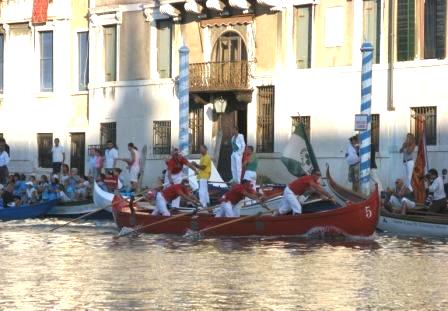
The most serious change in the past 20, or even 15, years is the steady decline in spectator boats. As I mentioned, Lino could climb over boats from hither to farther than yon all afternoon, but each year fewer Venetians come in boats to witness what was once one of their central events of the year. Even I have noticed the diminution of number of boats watching. There are many reasons for this but one of the primary ones is that the regata, on the whole, has been reshaped for tourists, either on land or watching TV, and therefore (for reasons I’ll spare you) it’s less interesting to be a participant. And the increase in motorboats has fatally weakened what was once a common language and connection with boats that are rowed.
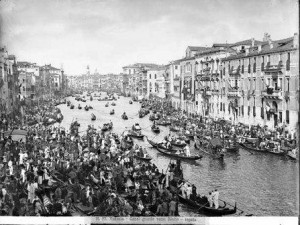
From being a crucial element of daily life for everyone, rowing has become a sort of boutique activity whose appeal is probably stronger as a picturesque curiosity to non-Venetians than to most locals, especially the younger ones.
Back to us. So we spend the afternoon hanging around watching the races and screaming if we should feel the need to for whoever our favorite racer(s) might be — and there have been times I have screamed so hard that I probably blew out some synapses, mine as well as the people nearest to me. I know the racers can’t hear me, but I also know they would notice if my voice weren’t in there somewhere. I know this. It’s a mystic racing thing.
As soon as the gondolini have crossed the finish line, everybody starts to leave. Instantly. Imagine everybody after the game trying to get out of the stadium parking lot at the same time. Lots of motors (not everybody who comes rows here anymore, unfortunately), and lots of motor-revving and choking exhaust fumes from these lovers of the oar.

Now comes almost the best part of all, which is the row back to the club. This takes about an hour because we’re not in a hurry; the sun is setting — it’s after 7:00 PM now — and the lagoon is calm and everyone is feeling happy and relaxed and it’s just one of the loveliest rowing interludes in the entire year.
We always stop, not far from the club, to open a bottle of wine (okay, two) and just sit and savor the moment out in the water all by ourselves. This year it was even sweeter than usual. The caorlina was not far behind us, and so we waited and then we tied the two boats together and just let the day and the moment and the sunset and the calm seep all the way through us.
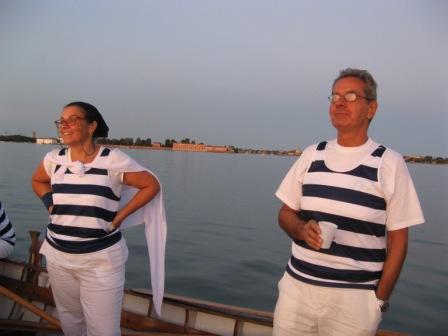

The moon, enormous and shining and orange, rose slowly above the treetops on the Lido. It was so beautiful it verged on the preposterous; Italians say that something like this, the final perfect touch, is the “cherry on the cake.” It was actually the moon on the cake. I’m sticking with that, at least I know what I mean.
The corteo is very nice, of course. But it’s something thousands of people (80,000 this year, by police estimates) can see, and anything that imitates something that once was genuine can hardly compare with something that is completely genuine right now. The corteo was a sort of imitation, but this was really ours. There were very, very few people who saw the lagoon as we did in the twilight with evening breath drifting around us and the moon’s radiance blooming out of the sky.
It all belonged to us and it needed no spectators or commentators. What a beautiful thing that is in this world, and how rare.
